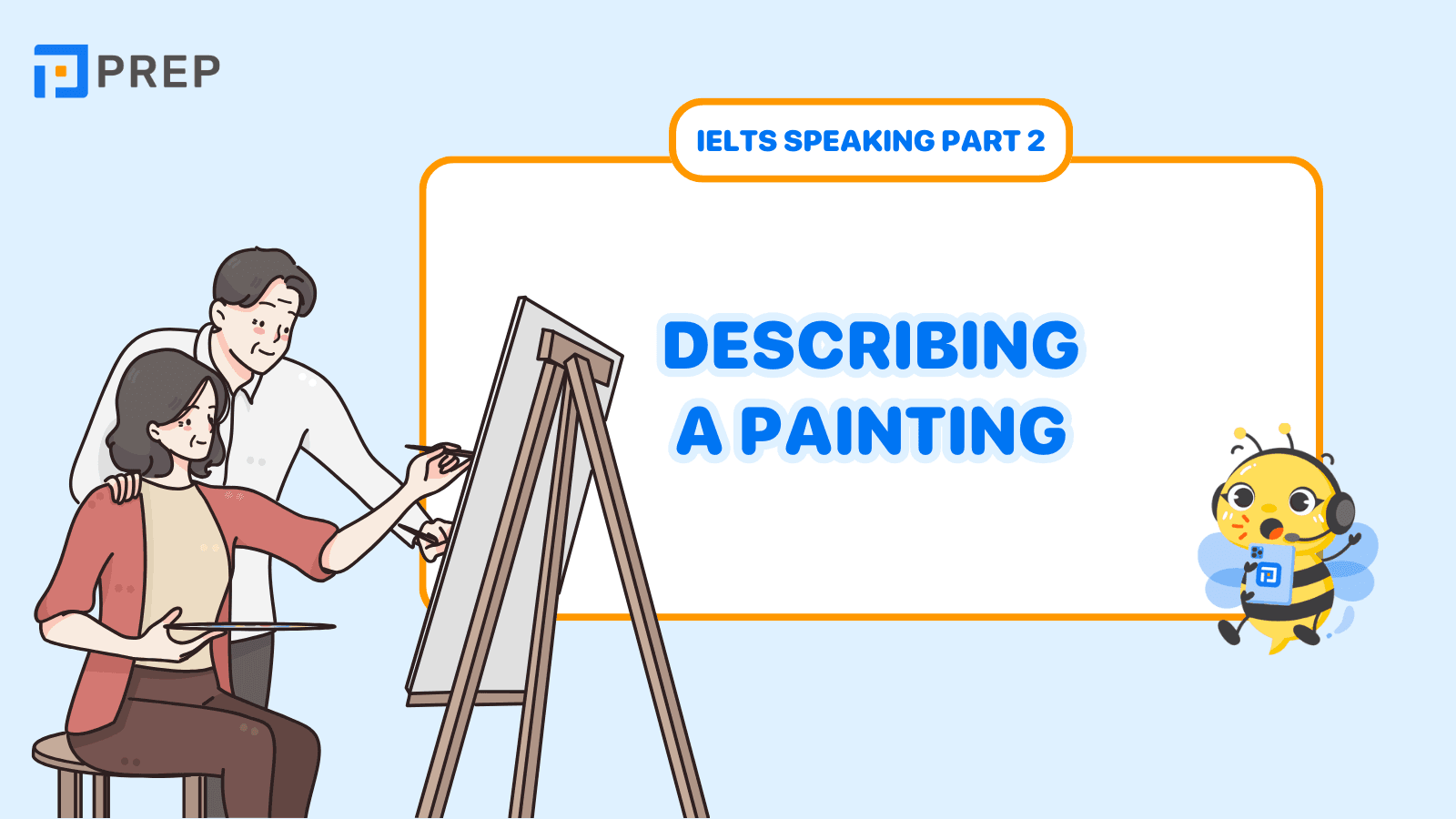Bài mẫu IELTS Speaking Part 2, 3: Describing a painting
Describing a painting/ Describe a piece of artwork that you have seen before/ Describe a painting or work of art that you have seen - 3 đề bài IELTS Speaking vô cùng khó nhằn trong đề thi thực chiến. Khi gặp phải những đề bài trên, chắc chắn thí sinh sẽ vô cùng hoang mang bởi vì chưa chắc bạn đã có tí kiến thức gì về nghệ thuật hay hội hoạ đúng không nào? Vậy thì để xử đẹp chủ đề Describing a painting, cùng prepedu.com brainstorm ở bài viết dưới đây thôi nào!

I. Bài mẫu IELTS Speaking Part 2: Describing a painting
1. Đề bài: Describing a painting
Describing a painting/ Describe a piece of artwork that you have seen before. You should say:
- Where you saw it
- What it was about
- When you saw it
And explain how you felt about it
[caption id="attachment_19703" align="aligncenter" width="820"] Describing a painting/ Describe a piece of artwork that you have seen before[/caption]
Describing a painting/ Describe a piece of artwork that you have seen before[/caption]
2. Dàn bài Part 2
2.1. Ý tưởng bài mẫu (tiếng Việt)
| Bối cảnh | Mô tả bức tranh: Describing a painting |
|
|
|
Cảm xúc + suy nghĩ |
|
|
|
2.2. Take-note trong 1 phút (tiếng Anh)
| Context | Mô tả bức tranh: Describing a painting |
|
|
|
Feelings + Thoughts |
|
|
|
3. Sample Speaking: Describing a painting
Dưới đây là bài mẫu IELTS Speaking Part 2 chủ đề Describing a painting được biên soạn bởi thầy cô giáo hạng A tại prepedu.com. Tham khảo ngay để học luyện thi IELTS hiệu quả tại nhà bạn nhé!
The lifelong passion I’ve always devoted for art makes this question a real challenge to answer, as most artworks I have seen left an impression on me. If a choice has to be made, though, I would settle with “Fallen angel”, which is a skilful oil on canvas by the wondrous Alexandre Cabanel in the 19th century.
I have never seen this piece of art in real life, instead stumbling upon it in the art sections on Youtube a few years back. A religious painting, “Fallen angel” is one of the first pictures to depict fallen angels - the ones who betrayed God and got expelled from heaven according to the Bible, taking the jurists of the competition to which this painting was sent aback.
Looking at the painting, one could see a fallen angel sitting atop a large rock, hiding most of his face behind flexed arms. Along with a posture akin to a guarded being in distress, the highlight of the artwork lies in the fallen angel’s pair of eyes, which convey a multitude of feelings. In the far distance, there are angels seemingly rejoicing in the blue shade of heaven.
To talk about how this painting makes me feel, whilst I am not a Christian, nor am I that accustomed to portrayals of fallen angels in art, the art piece stood out to me the exact moment I laid eyes on it. What drew me in were the sophisticated, almost impenetrable emotions in the main character’s eyes. It’s hard to say whether his eyes are boiling with anger, shame or defiance, but no matter what, everything about him screams relatable, which is not something I usually feel in academic art.
The background of the painting is also another intriguing factor. Despite the painting receiving hostile opinions from the critics at the time, being deemed inadequate and too romanticist in style, Cabanel insisted how he went through all the trouble so as to submit a piece of work that was more than the ordinary. This attitude towards art of his is an inspiration to me, and looking at the painting reminds me of art’s grandest purpose - inspiring people with things that are more than just the norms.
Một số từ vựng ăn điểm được sử dụng trong bài mẫu IELTS Speaking Part 2 chủ đề Describing a painting:
- skilful (a): khéo léo, tinh xảo
- oil on canvas (n): tranh sơn dầu
- wondrous (a): phi thường
- stumble upon (v): vô tình bắt gặp
- depict (v): khắc họa
- to be expelled from (phr): bị trục xuất
- jurist (n): giám khảo
- to be taken aback (phr): ngạc nhiên
- flexed (a): căng lên
- posture (n): tư thế
- akin to (phr): tương tự như
- guarded (a): dè chừng, đề phòng
- distress (n): sự đau khổ
- highlight (n): điểm nhấn
- a multitude of (phr): rất nhiều
- rejoice (v): hạnh phúc
- accustomed to (phr): quen thuộc với
- portrayal (n): sự khắc họa
- lay eyes on (phr): nhìn
- impenetrable (v): khó hiểu
- defiance (n): sự thách thức
- relatable (a): dễ liên hệ
- intriguing (a): thú vị
- hostile (a): thù địch
- critic (n); nhà phê bình
- deem (v): coi như
- inadequate (a): không đủ
- romanticist (a): theo trường phái lãng mạn
- insist (v): khăng khăng, quả quyết
- grand (a): lớn
- the norm (n): điều bình thường
II. Câu trả lời mẫu IELTS Speaking Part 3: Art
1. What is the general purpose of art?
That is a very philosophical question, and probably could meet with a plethora of answers. I think at the core, art has two most noble functions. First, art should always evoke emotion in people. Whether it is joy, melancholy, nostalgia or poignant pain, whether it is a portraiture, a sculpture, or life paintings, art needs to induce certain feelings. Second, I believe art serves as a self-expression method which enables people to narrate their own thoughts and stories in non-verbal forms.
- philosophical (a): thuộc về triết học
- a plethora of + n (phr): rất nhiều
- noble (a): cao quý
- evoke (v): khơi gợi
- melancholy (n): ảm đạm
- nostalgia (n): hoài niệm
- poignant (a): đau đớn
- portraiture (n): tranh chân dung
- life painting (n): tranh phong cảnh, đời sống
- induce (v): kích thích
- narrate (v): trần thuật
- non-verbal (a): không dùng đến từ ngữ
2. Do you think that art is as important as academic subjects when it comes to educating children?
Definitely yes. In general, art has been scientifically proven to help develop a kid’s creativity and sense of individual identity, which is essential for their future development. The creativity that art helps foster may immensely improve children’s well-being and happiness, since compared to other academic subjects, art is not as stressful and rigid. Moreover, seeing how the same object and emotion can be expressed in diverse ways can nurture children’s tolerance and even better, acceptance towards differences around them.
- sense of individual identity (phr): ý thức về bản sắc cá nhân
- foster (v) = nurture (v): nuôi dưỡng
- rigid (a): cứng nhắc
- tolerance (n): sự chấp nhận
3. What are the advantages and disadvantages of art education?
I think art can sometimes be brushed aside in the school curriculum as people tend to undermine its values and consider art education costly and even a total waste of time. Do I think it can be quite a big sum of money? In many cases, yes, as the stationaries and tools needed for teaching art can take a certain toll on the school’s budget. However, the benefits for students of varying ages are way more immense. At the end of the day, what subject can teach people hand-eye coordination and healthy self-expression better than art?
- to be brushed aside (phr.v.): bị cho ra rìa
- undermine (v): đánh giá thấp
- big sum of (money): một số tiền lớn
- take a toll on (phr.v.): gây ra mất mát, thiệt hại
- hand-eye coordination (n): phối hợp tay mắt
Trên đây là bài mẫu IELTS Speaking Part 2 + 3 chủ đề Describing a painting. Tham khảo chi tiết sample Speaking Describing a painting để học luyện thi hiệu quả tại nhà và chinh phục được band điểm Speaking thật cao trong kỳ thi thực chiến sắp tới nhé!

Chào bạn! Mình là Hiền Hoàng, hiện đang đảm nhận vai trò quản trị nội dung sản phẩm tại Blog của website prepedu.com.
Với hơn 5 năm tự học các ngoại ngữ như tiếng Anh, tiếng Trung và ôn luyện một số kỳ thi IELTS, TOEIC, HSK, mình đã tự đúc rút được nhiều kinh nghiệm để hỗ trợ hàng nghìn người đang gặp khó khăn trong việc học ngoại ngữ. Hy vọng rằng những chia sẻ phía trên sẽ giúp ích cho bạn trong quá trình tự ôn luyện thi hiệu quả tại nhà!
Bình luận
Nội dung premium
Xem tất cảLộ trình cá nhân hoá
Có thể bạn quan tâm
Kết nối với Prep
MSDN: 0109817671.
Địa chỉ liên hệ: Tòa nhà Vinaconex, 34 Láng Hạ, phường Láng, TP Hà Nội.
Địa chỉ kinh doanh: Lô 21 C2 Khu đô thị Nam Trung Yên, phường Yên Hòa, TP Hà Nội.
Trụ sở: Số nhà 20, ngách 234/35 đường Hoàng Quốc Việt, phường Nghĩa Đô, TP Hà Nội.
Phòng luyện ảo - Trải nghiệm thực tế - Công nghệ hàng đầu.
Hotline: 0931 42 8899.
Trụ sở: Số nhà 20, ngách 234/35 đường Hoàng Quốc Việt, phường Nghĩa Đô, TP Hà Nội.
Giấy chứng nhận hoạt động đào tạo, bồi dưỡng số 1309/QĐ-SGDĐT ngày 31 tháng 07 năm 2023 do Sở Giáo dục và Đào tạo Hà Nội cấp.























